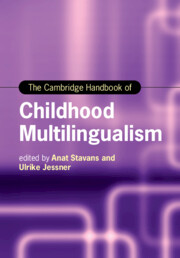Book contents
- The Cambridge Handbook of Childhood Multilingualism
- Cambridge Handbooks in Language and Linguistics
- The Cambridge Handbook of Childhood Multilingualism
- Copyright page
- Contents
- Figures
- Tables
- About the Editors
- Contributors
- Acknowledgments
- Multilingualism Is Not Bilingualism +1: An Introduction
- Part One Becoming and Being a Multilingual Child
- 1 Infant Bi- and Multilingual Development
- 2 The Development of Childhood Multilingualism in Languages of Different Modalities
- 3 Multilingualism in Early Childhood: The Role of the Input
- 4 Multilingual Education in Formal Schooling: Conceptual Shifts in Theory, Policy and Practice
- Part Two Cognition and Faculties in Multilinguals
- Part Three Family Language Policy
- Part Four Language(s) and Literacy of Multilingual Children through Schooling
- Part Five Socialization in Childhood Multilingualism
- Part Six Multilingual Children’s Landscape
- Subject Index
- Country Index
- Language Index
- References
2 - The Development of Childhood Multilingualism in Languages of Different Modalities
from Part One - Becoming and Being a Multilingual Child
Published online by Cambridge University Press: 18 August 2022
- The Cambridge Handbook of Childhood Multilingualism
- Cambridge Handbooks in Language and Linguistics
- The Cambridge Handbook of Childhood Multilingualism
- Copyright page
- Contents
- Figures
- Tables
- About the Editors
- Contributors
- Acknowledgments
- Multilingualism Is Not Bilingualism +1: An Introduction
- Part One Becoming and Being a Multilingual Child
- 1 Infant Bi- and Multilingual Development
- 2 The Development of Childhood Multilingualism in Languages of Different Modalities
- 3 Multilingualism in Early Childhood: The Role of the Input
- 4 Multilingual Education in Formal Schooling: Conceptual Shifts in Theory, Policy and Practice
- Part Two Cognition and Faculties in Multilinguals
- Part Three Family Language Policy
- Part Four Language(s) and Literacy of Multilingual Children through Schooling
- Part Five Socialization in Childhood Multilingualism
- Part Six Multilingual Children’s Landscape
- Subject Index
- Country Index
- Language Index
- References
Summary
Multilingualism is not only limited to people or communities using multiple spoken languages, and complex linguistic diversity of signing communities is often seen among signers. This chapter focuses on the special type of multilingualism of children who are acquiring both sign language(s) and spoken language(s) from their linguistic environment, also referred to as bimodal multilingualism. As sign languages and spoken languages are partly produced and received in two different modalities (visual-gestural and vocal-auditory), the multilingualism of these children involves two different modalities. This chapter discusses the bimodal multilingualism of hearing and deaf children who are acquiring both sign and spoken languages. The chapter describes the multifaceted linguistic landscape and environment of bimodal multilingual children, the access of bimodal multilingual children to different languages, and the use of different languages in a variety of social contexts. Additionally, the chapter illustrates the process of bimodal multilingual language acquisition and challenges to maintain the acquired language abilities as heritage language users, as well as the attainments and usage of hybrid linguistic resources.
Keywords
- Type
- Chapter
- Information
- The Cambridge Handbook of Childhood Multilingualism , pp. 38 - 57Publisher: Cambridge University PressPrint publication year: 2022
References
- 2
- Cited by

